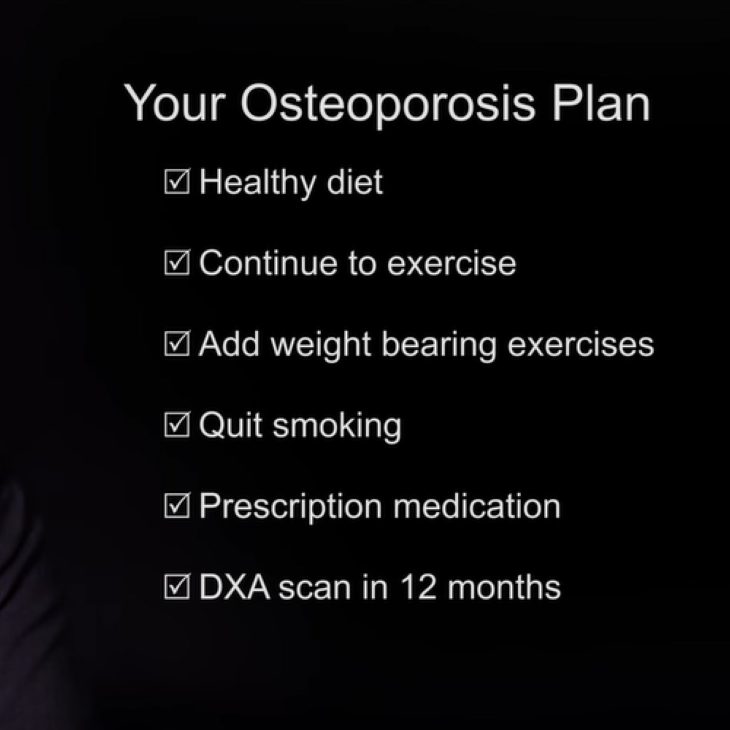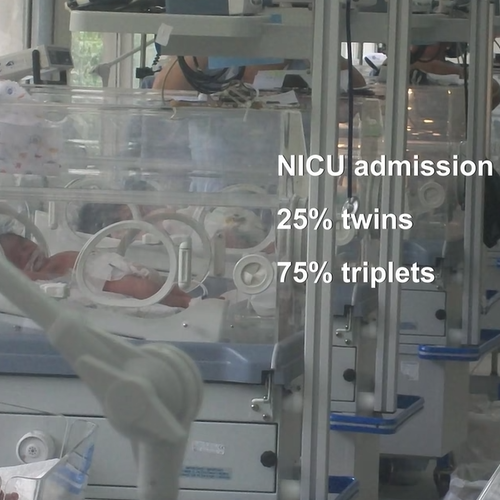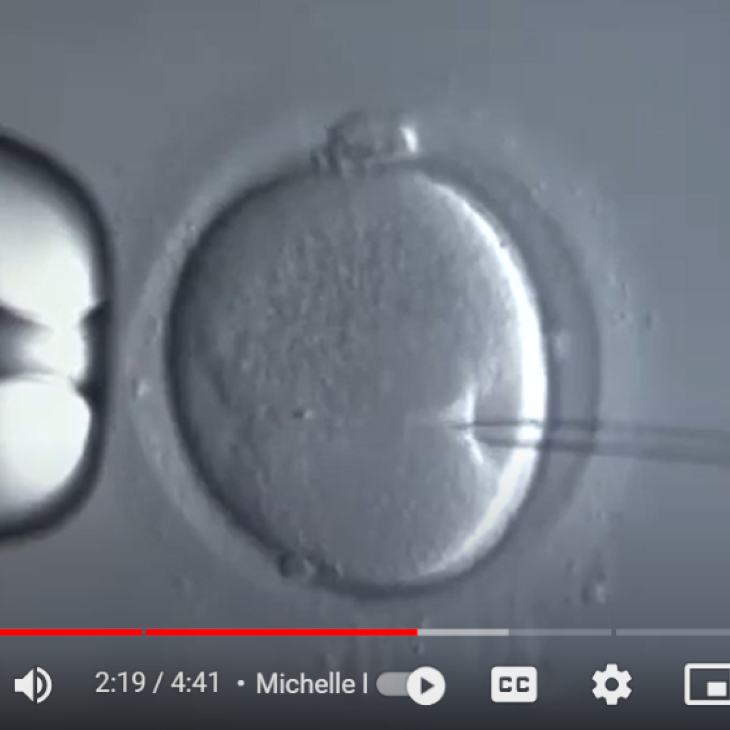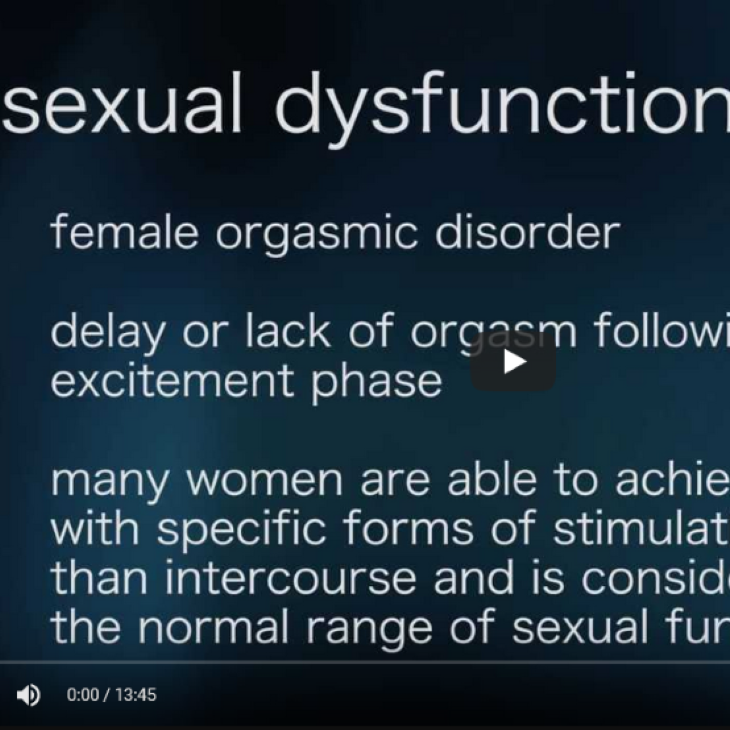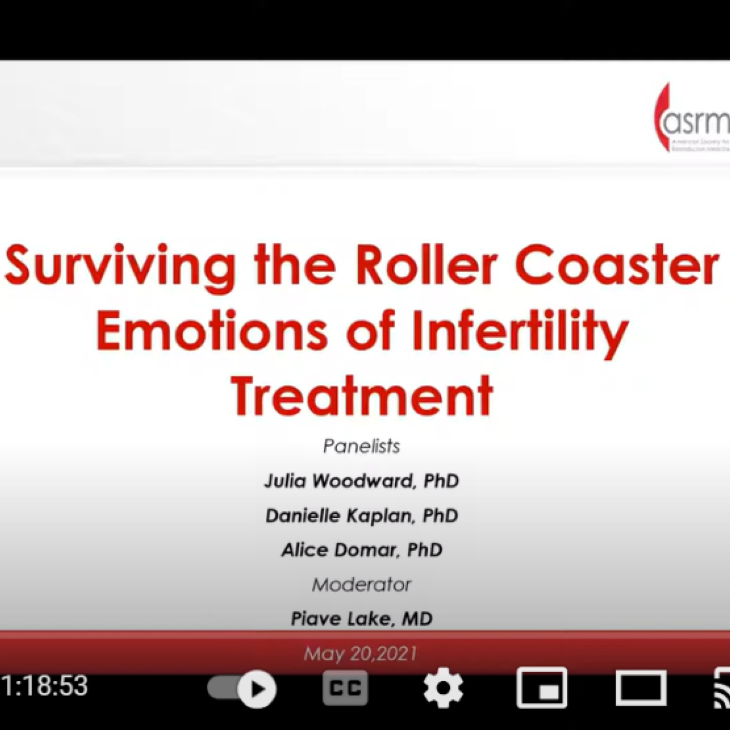Infertility
Transcript
Infertility is the result of a disease (an interruption, cessation, or disorder of body functions, systems, or organs) of the male or female reproductive tract which prevents the conception of a child or the ability to carry a pregnancy to delivery.
A 34-year-old woman and her husband come to their doctor for evaluation and treatment for infertility. She gave birth to a healthy girl 3 years earlier but she and her husband have been trying to conceive again for 1 year without success. Although her menstrual periods used to come regularly every 26-28 days apart, they now occur up to 40 days apart. Her doctor noticed hair growth under her chin and down the middle of her abdomen. After further testing she was diagnosed with polycystic ovary syndrome and she was found not to be ovulating regularly. Her husband was evaluated as well and his sperm count and sperm motility was found to be mildly low on several occasions. The couple discussed different options for fertility treatment with their doctor and they decided to use clomiphene citrate pills to improve her ovulation. She also had an intrauterine insemination that was timed around her ovulation. After three months of treatment, the couple conceived and 9 months later she delivered a healthy baby boy by vaginal delivery.
If you are trying to get pregnant, you are not alone.
If you are watching this because you have been having difficulty becoming pregnant – remember – you are one of many who are experiencing the same difficulty! Millions of men, women, and couples seek medical care each year for the same reason! The good news is that many patients are successful in achieving their dream!
10%-15% of all couples have difficulty becoming pregnant or meet the definition for infertility. There are many reasons why couples may not become pregnant as quickly as they would like. Seeking assistance will often help you to achieve your goal! Over 80% of couples will achieve pregnancy after trying to conceive for 1 year and 90% will get pregnant if they continue trying for another year. For many couples, pregnancy is just a matter of time. Some couples may even become pregnant during the process of seeking help! It is important to have patience. However, it is also important to seek medical care from a trained fertility specialist to help provide answers and guidance.
As time goes on without a pregnancy, couples should strongly consider seeing an expert. The purpose of seeing a fertility specialist is to determine if any specific reason can be identified that may be causing a delay in achieving pregnancy. Reproductive endocrinologists are specialists trained for this very purpose. They have training in obstetrics and gynecology with further training in fertility. They stay up to date on the best diagnostic and treatment options available. A specialist can sit down and talk with you and explain what treatment options may be best for you!
Many couples choose to wait until they have been trying to conceive for 12 months with regular sexual intercourse. It is also appropriate for some women to see a specialist earlier. Women over the age of 35 should consider seeing a specialist after 6 months of trying to become pregnant. Others may wish to seek care earlier, particularly if something in your medical history suggests a potential reason for infertility. Some of these reasons include very irregular menstrual cycles, a previous history of ectopic pregnancy or pelvic infection, male or female exposure to radiation or chemotherapy, or a history of endometriosis.
Who should be evaluated by a specialist?
Both men and women should meet with a specialist together, at least at some point in the evaluation. Both partners may have an underlying problem that is contributing to infertility. In almost every case, the stress of not achieving pregnancy affects both partners. It is important to support each other in order to make the process easier. Sometimes men will be advised to consult with a urologist who specializes in male infertility. We will discuss this later in more detail.
Many couples will find one or more reasons for their infertility after evaluation by a specialist. Sometimes the reason may be straightforward and easy to address, while other times more advanced treatment is required. Some of the main causes of infertility are problems with ovulation (releasing an egg from the ovaries), abnormalities of the sperm, a blockage in one or both fallopian tubes, fibroids, endometriosis, and age-related changes in the function of the ovaries. In some cases, no obvious explanation can be found (unexplained infertility). This does not mean that no reason exists. It simply means that no common, easily detectable cause has been found. But be assured – regardless of your diagnosis, treatment options exist!
Couples often wonder: What will the specialist say? What tests will be ordered? How long will it take to find a cause? Will the tests hurt? My friend had this test, will I have the same test myself?
You should know that no standard set of tests is used for every patient and for every couple. Some patients need more tests than others. Most tests are easily and quickly performed and are not painful in any way. In just a moment, we will go through some of the most common tests you may have performed by your specialist.
At the same time that you undergo fertility testing, your doctor may order laboratory tests for you and your partner. These are tests that make sure your body is ready for pregnancy. The tests often include checking for infections such as HIV and hepatitis, your blood count and blood type, and may include genetic screening. If you have any chronic medical conditions such as high blood pressure or diabetes, your doctor may run tests to make sure these conditions are optimized.
Your doctor will want to know whether or not you are ovulating, or releasing an egg, and exactly when each month this occurs. You may be asked if you have regular menstrual cycles, how far apart your cycles are, and if you have any bleeding between your menstrual cycles. Most women who have regular bleeding patterns (every 25-32 days), usually ovulate on a regular basis. But your doctor may perform one or more tests to verify this. Some doctors may advise using a basal body temperature or BBT chart. When using a BBT chart, you take your temperature everyday when you first wake up. Usually an electronic thermometer is used and you record your findings on a special chart or graph. Some couples may prefer to use the many computer programs or applications that are available. Because your temperature rise is noted after you’ve already ovulated, this test is not considered reliable in predicting when you release an egg.
You can also use a urine test kit to detect a rise in luteinizing hormone or LH. LH is produced by the brain in the pituitary gland and is the trigger for ovulation. An LH test (ovulation predictor kit) determines the time of ovulation approximately 12-36 hours before it occurs. When the test is positive, a couple can time intercourse. However, this test should only be used by women who have monthly menstrual cycles. Your doctor may also order a blood test of your progesterone level. This hormone usually rises after ovulation. If the progesterone level is above 3 ng/mL, then you have ovulated. It’s important to know that the progesterone test does not give any information about the quality of ovulation.
If you have a male partner, a semen analysis should be performed. A semen analysis evaluates the number, shape, and movement of sperm. In up to 50% of all couples, there can be abnormalities identified in the sperm. Don’t be alarmed. The vast majority of these are very mild. And there can be variation between sperm samples, so usually when an abnormality is seen, the test is repeated. The laboratory measures many things when running a semen analysis, but several parts of the test are important. Certainly the number of sperm is important. This number may be given to you as a total sperm count or as a sperm concentration. Generally a sperm concentration of greater than 15 million sperm per milliliter is considered normal. The number of moving sperm, the sperm motility, is measured as the percent of sperm that are moving-- 40% or more moving sperm is considered normal. Finally, a specialized test called sperm morphology may be performed. For this particular test, individual sperm are viewed under a microscope to check their size and shape. Determining normal sperm morphology varies among laboratories.
Men might be asked to see a urologist for a variety of reasons. There may be abnormalities in one or a combination of sperm measurements on the semen analysis. Explanations for these problems can be further investigated. For instance, a urologist will perform a physical examination of the penis and testicles to check for a varicocele, which are enlarged blood vessels next to the testicles. These enlarged blood vessels increase the temperature of the testicles and can affect sperm number and quality. When appropriate, there may be lifestyle or surgical interventions that can help improve this problem. In rare cases, there may be no sperm seen on a semen analysis, called azoospermia. A urologist, preferably one trained in male infertility, can work with your fertility specialist to help investigate whether azoospermia is because no sperm is being produced or because the sperm that are produced are blocked from being released during ejaculation. Additional hormonal and genetic blood tests may be needed. In some cases, surgical removal of sperm may be necessary. The important thing to remember is that very successful treatments are available for couples with normal sperm, mildly abnormal sperm, and for couples with severe sperm abnormalities.
For many couples, the choice of infertility treatment often depends on how a woman’s fallopian tubes are working. Women normally have 2 fallopian tubes and each tube serves as a passageway to allow sperm to travel upward and the egg to travel downward so that the two can meet. The fallopian tubes can be damaged in many ways. Damage often occurs from past infections inside the abdomen including appendicitis, pelvic inflammatory disease, or cervical infections such as gonorrhea and chlamydia. Not all infections cause symptoms, so it’s possible to have an infection and never know it. Damage to, scarring, or blockage of one or both fallopian tubes may result from endometriosis and previous surgery such as laparoscopy or open surgery near or on the fallopian tubes or ovaries.
A common test to evaluate fallopian tubes is a hysterosalpingogram, also known as an HSG. This test is usually performed in a hospital or outpatient radiology center, either by your fertility specialist or by a radiologist. While the doctor injects contrast material or dye into the cervix, x-rays are taken to see if the endometrial cavity, the inside of the uterus where a pregnancy would grow, has a nice smooth shape, and to see if the contrast material goes into and travels out the ends of each fallopian tube, confirming whether one or both fallopian tubes are open.
Your doctor may discuss the term “ovarian reserve.” This is a medical term used to describe how your ovaries work, specifically their ability to produce eggs and respond to treatment. Not everyone needs this type of testing. Women with irregular menstrual cycles will often be tested. As women become older, their ovarian reserve is expected to decline. There is no specific age as to when this happens and there is tremendous variation among women. There are several ways to test for ovarian reserve. One method is an ultrasound during the first few days of the menstrual period to count the number of very small follicles on each ovary, also called an antral follicle count. Having more follicles is generally a good prognostic sign.
You may also have some blood tests performed. The most common test is the follicle stimulating hormone, or FSH level. This is a natural hormone in your body that plays a large role in the growth and development of your eggs. Your doctor may perform an FSH level on Day 3 of your menstrual cycle. Over time, a woman’s FSH level tends to go up and that is expected. Your doctor is usually looking to make sure it has not risen too high. The FSH test is feared by many women and for some women is it the source of a significant amount of stress. It’s important that you understand this is a screening test. It is simply a test. And whether the test is high or low, normal or abnormal, it does not tell your doctor exactly what happens in your body and it does not determine whether or not you will become pregnant. More than anything else it can help your doctor counsel you on the best options for treatment.
Another test that can be used to determine ovarian reserve is antimüllerian hormone or AMH. This hormone can be tested at any time of the menstrual cycle or while taking hormonal contraceptives. AMH is produced by the cells inside the follicles. The levels of AMH go down months or years before an abnormal rise in FSH is detected. The cut-off point to determine an abnormal value varies depending on the laboratory.
You may have an ultrasound, also called a sonogram, at some point in your evaluation. An ultrasound may be performed to evaluate the uterus and the ovaries. As mentioned earlier, an ultrasound may be used for an antral follicle count at the beginning of your menstrual cycle, or it may be used to follow the growth and development of follicles later in your cycle. An ultrasound can also measure the thickness of the inner lining of your uterus where a pregnancy would implant and grow. Fibroids, which are common noncancerous overgrowths on the uterus, may also be detected by ultrasound and followed over time. Although an ultrasound is sometimes uncomfortable, it is not a painful test.
A laparoscopy is a minimally invasive surgical procedure. Even though it is a minimally invasive surgery, it is probably the most invasive of any of the tests that your doctor may recommend. A laparoscopy involves a camera attached to a telescope that is usually placed through a very small incision in your belly button into your abdomen to look at the internal structures. These structures include the uterus, the fallopian tubes, the ovaries, and the pelvis in general. Most women do not have a laparoscopy and it should not be performed on a routine basis. However, your doctor may recommend this for several reasons. These include an abnormality of the fallopian tubes requiring further investigation, an abnormality of the uterus, a high suspicion for endometriosis, or for further clarification if nothing else in your testing explains your difficulty in getting pregnant.
This basic review of testing procedures is meant to be a guide.
Not every patient undergoes the same tests. Your specialist will review your history and make individual recommendations. Most tests are very simple, but some tests are a little more time consuming. In most cases, you will be able to complete all the tests over the course of about 4-5 weeks. The purpose of these tests is to try to provide answers as to why achieving pregnancy has not been easy for you. These tests also help you doctor tailor an appropriate treatment plan. But remember - in some couples all of the tests will be normal and no explanation will be found. That is ok. Plenty of treatment options exist and the vast majority of couples are able to conceive.
Discuss your options with your doctor. You will soon discover that each option has its own set of distinct advantages and disadvantages. Together with your doctor you can make a treatment plan that you are comfortable with and that makes the most sense for you! Always keep in mind that the goal is not to have a particular test or to have a specific treatment, but to have a happy and healthy child!
Infertility
Female Fertility
Male Fertility/Andrology
Find a Health Professional










